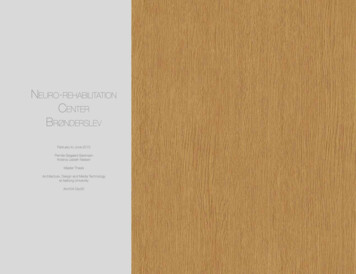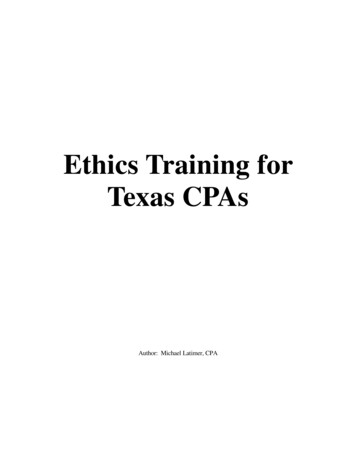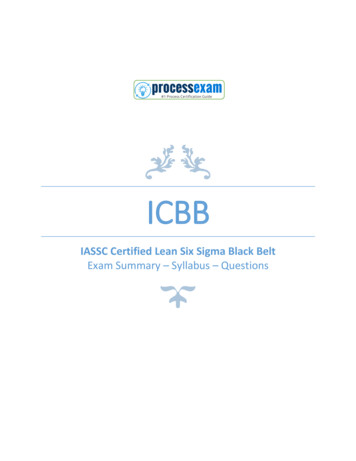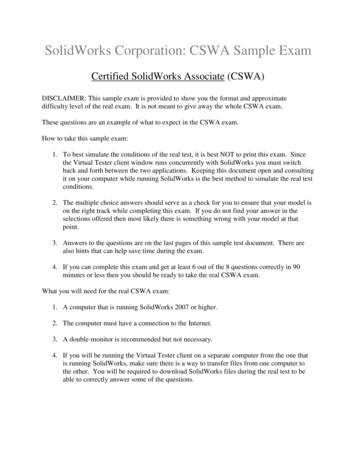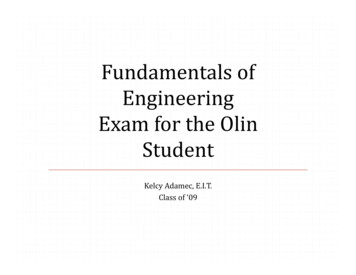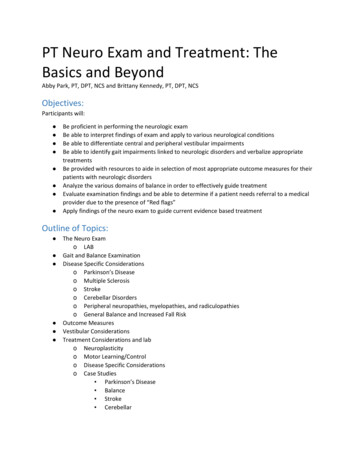
Transcription
PT Neuro Exam and Treatment: TheBasics and BeyondAbby Park, PT, DPT, NCS and Brittany Kennedy, PT, DPT, NCSObjectives:Participants will: Be proficient in performing the neurologic examBe able to interpret findings of exam and apply to various neurological conditionsBe able to differentiate central and peripheral vestibular impairmentsBe able to identify gait impairments linked to neurologic disorders and verbalize appropriatetreatmentsBe provided with resources to aide in selection of most appropriate outcome measures for theirpatients with neurologic disordersAnalyze the various domains of balance in order to effectively guide treatmentEvaluate examination findings and be able to determine if a patient needs referral to a medicalprovider due to the presence of “Red flags”Apply findings of the neuro exam to guide current evidence based treatmentOutline of Topics: The Neuro Examo LABGait and Balance ExaminationDisease Specific Considerationso Parkinson’s Diseaseo Multiple Sclerosiso Strokeo Cerebellar Disorderso Peripheral neuropathies, myelopathies, and radiculopathieso General Balance and Increased Fall RiskOutcome MeasuresVestibular ConsiderationsTreatment Considerations and labo Neuroplasticityo Motor Learning/Controlo Disease Specific Considerationso Case Studies Parkinson’s Disease Balance Stroke Cerebellar
The Neuro Exam:Gives you the following information: Info needed for general screen or referral Identification of "red flags" Range of impairments What you can treat vs. what affects treatment Localization for diagnosis Baseline impairments/function***Not all aspects of the neuro exam need to be tested with every patient! Choose most appropriatebased on diagnosis and prioritize based on time available***Observation: Starts immediately when you walk into the roomExamples (not inclusive list): Posture, posturing, tremor, devices, skin changes/bruising, musclewasting, reliance on others, room set up, caregiver assist. Observation should help to guide your subjective and objective examCognition and Alertness: Level of arousalOrientation: Person, place and time- may test with various dementiasDo they follow directions?Sudden changes may indicate medical issues & need for further follow upApraxia- included here as this may appear to be a cognitive problem, but it is actually a motorproblem. Unable to select appropriate motor program to perform tasks on command. Result ofbrain damageSensation: Purpose of testing: Identify the need for further testing, can help in determining prognosis bygiving you a range of impairments you are working with and can help with diagnosis whenuncertainSensation and motor function are strongly linked- sensation is used as feedback duringmovement to adjust & correct. It gives information about environment and relation of body tothe environmentDistributions: Gives information to localize problem Cortical- follows sensory homunculus Peripheral- follows peripheral nerve distribution Spinal nerves- follows dermatomal distribution
Sensory Tracts Dorsal Column/Medial Lemniscus Light touch Proprioception Vibration- typically first affected in diabetic neuropathy Two-point discrimination Crosses at the level of the medulla in the brainstem Spinothalamic Tract Sharp/dull Pain/temperature Crosses immediately upon entering spinal cordConsider EXTINCTION testing Inattention to 1 side when sensory input is given bilaterally and simultaneously Occurs with damage to the sensory cortex- the side not noticed is opposite the side ofcortical damageTesting Sensation Choose sensation tests which might give you the most information Make sure eyes are closed Move from distal to proximal or in a sequence (dermatomal, etc.) Test general body areas for light touch if suspect cortical damage
Test dermatomes if you suspect nerve root damage Proprioception Ability to feel where our body is in space Largest effect on movement Smallest joints have least amount of extraneous movement when testing Testing: Be sure to have hands on the side of the joint so as not to give pressure cuesReflexes: Deep Tendon Reflexes Helps distinguish UMN vs LMN problem UMN: hyperreflexia LMN: diminished reflexes Grading 4 : very brisk, hyperactive 3 : Brisker than average, possibly but not necessarily indicative of disease 2 : Normal 1 : Somewhat diminished/ low normal 0: Absent Superficial Cutaneous Reflexes: Signs of upper motor neuron involvement Clonus- move ankle quickly into dorsiflexion Positive- beats into plantarflexion (1-2 beats may be normal) Hoffman’s- flick terminal phalanx of the middle or ring finger Positive- terminal thumb phalanx flexion Babinski- stimulate foot along lateral border Positive- toes extend/move apartTone/Spasticity: Tone: Test by performing passive movement of upper and lower extremities Everyone has some degree of normal toneSpasticity: Increased muscle tone Velocity Dependent UMN sign- lack of central inhibition Can grade using Modified Ashworth Scale Flaccidity: decreased muscle toneRigidity
Sign of basal ganglia damageTest in distal aspects of limb (wrist and elbow flex/extension, ankle and kneeflexion/extension) May be continuous or ratchety (cogwheeling) NOT velocity dependent To intensify add an activation maneuver with opposite UERange of Motion: Test to get an idea of strength (active ROM), tone (passive ROM), contractures andcompensations used for function. Goniometers?Strength: In UMN Lesion, strength deficit is a decreased force production because of inadequate input toalpha motor neuron Strength testing can give information on lesion location similar to sensory examination Other contributions to decreased strength: Postural set Decreased motor contribution from M1 Problems with sequencing Disuse/atrophy Sensory loss AttentionCoordination: Ability to use parts of the body together smoothly and effectivelyBrain areas involved: Motor and sensory cortices Cerebellum Basal GangliaTest the following on exam: Rapid alternating movements Accuracy of movement Finger to nose Fixation/limb holding Equilibrium/postural stability Also note how it affects gait/functionCranial Nerves:
**Do not need to be tested for every neuro diagnosis. Test when you suspect damage to brainstem. Notall cranial nerves have an impact on function, therefore not all need to be tested if known brainstemlesion. May give more information to test all if diagnosis or lesion location is unknown.No.NameS/M/BFunctionHow to Test1.OlfactorySSmellIdentify smell2OpticSVisionPupillary reflex (sensory)Check vision3OculomotorMMoves eye up/down/medial,raises upper eyelid, constrictspupil, adjusts lens shapeCheck eyelids open equallyTrack fingerPupillary reflex (motor)4TrochlearMMoves eye medial/downTrack finger5TrigeminalBFacial sensation, chewingSensation of faceMuscles of masticationCorneal reflex (Sensory)6AbducensMAbducts eyeTrack finger7FacialBFacial expression, closes eye,tears, salivation, tasteFacial movementsCorneal reflex (motor)8VestibulocochlearSHearing, head position relativeto gravity & mvmtVestibular functionAuditory function9Glossopharyn BgealSwallowing, salivation, tasteSay “ahh”10VagusBSwallowing, speech, taste,regulates visceraSay “ahh”11SpinalAccessoryMElevates shoulders, turns headMMT sternocleidomastoid andupper trap12HypoglossalMMoves tongueHave patient stick out tongueGait and Balance Examination: Gait Examination Ranchos Los Amigos gait cycle evaluation: Stance Phase
Initial Contact Loading Response Mid stance Terminal stanceSwing Phase Pre-swing Initial swing Mid swing Terminal SwingConsiders: weight acceptance, single limb support, and single limb advancementKey Muscles to consider: Trunk Hip Knee AnkleSystem for Evaluation Considerations: either look proximally to distally or distally to proximally Look at trunk, pelvis, knee, and ankle - strength, ROM, tone, and coordination Also look at: arm swing, head position, and overall postureEvaluating swing phase: Limb advancement Limb clearance Coordination of hip, knee, and ankleEvaluating stance phase: Stability of pelvis, trunk Stability of knee Weight Shift Weight acceptanceBalance Evaluation: Normal Postural Control and Balance
Requires combination of consideration of the individual, the environment, andthe task itselfWhat affects balance?The basics of good balance Sensory input leads to motor output Sensory information Visual Vestibular Somatosensory
Motor Output Erector spinae Abdominals Iliopsoas Glute medius Tensor fascia latae Biceps femoris Gastrocnemius/soleus Tibialis anterior
Balance Strategies Anticipatory Reactive Fixed support (body stays stagnant) ankle hip knee bend reach for support Change in support reactions (allowed to move body in space to regainbalance) stepping reaction reach outside and move trunk for support Feedback mechanisms Feedforward mechanismsAbnormal postural control Abnormal sequencing delay in recruitment decreased torque co-contraction of muscles timing of contraction Scaling of balance reactions Adaptation to balance challengesSystematic Evaluation of balance - Six Considerations evaluated in the BESTest(Appendix 1) Biomechanical Constraints Stability Limits and Verticality Transitions and Anticipatory balance
Reactive balanceSensory OrientationStability in GaitDisease Specific Considerations for Examination:Parkinson’s Disease Pathophysiology: Progressive loss of dopamine in the basal gangliaBasal ganglia’s role: Initiates, stops, monitors and maintains movement. Functions as a "brakingsystem" to inhibit undesired movement and permit desired ones.4 Cardinal Signs Tremor Rigidity (Cog Wheeling) Use activation maneuver Bradykinesia Detected in functional mobility, coordination testing Postural Instability Pull TestCoordination Testing Finger Tapping Mass grasp Pronation/Supination ("turning door knob") Toe tapping Leg AgilityThings to look for: Rhythm broken/hesitations in movement Slowing of movement Decreased amplitude of movementThings not affected: strength, sensation, reflexes kinsons-sign-while-hypertonia-is-present for more information), cranialnerves (though many have loss of smell as an early symptom)Balance Considerations: Loss of balance reactions Loss of automatic postural control Abnormal sequencingParkinsonian Gait: Shuffling Short step length bilaterally, mid foot contact, flexed forward at hips, often lackarm swing unilaterally Festinating gait Unable to control forward movement of trunk -- leads to falling Freezing
Multiple Sclerosis: Pathophysiology: demyelination occurs in the central nervous system in the brain and/or spinalcord. Signs and symptoms will depend on the areas of demyelinationCommon Signs: Sensory impairment with complaints of numbness or paresthesias in a cortical ordermatomal pattern Motor impairment in cortical or myotomal pattern Spasticity Vision and oculomotor deficits including deficits in acuity, ocular alignment, andoculomotor Coordination and ataxia Dizziness Fatigue - primary and secondary Bowel and bladder impairment (spasticity) Heat sensitivity Balance deficits fallsExamination considerations Main points: UMN signs, localization in cortex, brainstem, cerebellum, or spinal cord Objective findings may lead you to at least two localization points (historically orobjectively) To be diagnosed, must have demyelination in two different areas Cranial nerve evaluation, especially oculomotor Coordination testing: ataxic, dysmetric movements if cerebellum is involved rapid alternating movements finger to nose heel to shin Tone assessment: Modified Ashworth Scale - expect hypertonicity Reflex assessment: expect hyperreflexia, presence of abnormal reflexes - babinski andclonus Sensory Testing: light touch, sharp/dull, proprioceptive testing Manual Muscle Testing Cognitive Screen: alertness and orientation, MoCA Fatigue assessment: Modified Fatigue Impact Scale (full and 5 item) Complete vestibular exam as indicatedBalance assessment Important to consider static and dynamic balance Likely to have poor sensory input (visual loss, vestibular loss, and poor somatosensation)as well as inability to produce good motor output - poor muscle strength, sequencing,and coordinationGait assessment Impairments that will lead to gait deficits: Weakness Poor sensory input Spasticity
Impaired coordinationCommon deficits seen: Poor foot clearance due to: foot drop, weak hip flexors, and/or spasticity inplantarflexors steppage gait circumduction vaulting Trendelenburg due to weak glute medius Ataxia Evidence of balance issues: path deviation wide BOS Slow cadenceStroke: Pathophysiology: vascular event leading to damage of brain tissue supplied by that vesselSigns and symptoms vary significantly depending on vessel affected (appendix 2) Most common: MCA, ACA, PCA Other common: lacunar, cerebellar, and vertebrobasilarCommon impairments to examine: Motor: Loss in cortical distribution unilaterally hemiplegia Consider proximal strength of scapular stabilizers, pelvis, and hip UE often more affected than LE LE muscles often affected: dorsiflexors, quadriceps, hamstrings, and gluteusmaximus Sensory Loss in cortical distribution in unilateral May be complete sensory loss or partial Test light touch, proprioception, sharp/dull Cranial Nerves Oculomotor impairment Palate and uvula deviation Tongue deviation Facial droop with forehead/eyebrow movement preserved Reflexes Hypertonicity unilaterally Unilateral abnormal reflexes Cognition Executive dysfunction Memory impairments Emotional lability Postural assessment: sitting and standing Ability to sense upright
Even weight distribution left to right Signs of pusher syndrome Speech deficits Word finding deficits Slurred speech Non-sensical words/paraphrasing aphasiaBalance evaluation Static and dynamic balance assessment is important Deficits with co-contraction of muscles, torque, and sequencingGait Evaluation Swing Phase Foot drop Difficulty with limb advancement due to hip weakness Limb external rotation with pelvic retraction Compensations: circumduction steppage vaulting Ability to achieve positive step length Stance Phase Foot slap with initial contact Decreased knee stability in midstance Difficulty with weight acceptance and weight shift Trendelenburg Pelvic retraction Time in single limb stanceCerebellar Disorders: WIDE variety of various pathologies that can affect the cerebellum. Most common is cerebellarCVA or cerebellar degeneration, though there can be inherited conditions which also affect thecerebellumFunction of the Cerebellum: Motor Coordinator Controls activity of multiple muscles across several joints Regulates force, distance, timing, duration Predicts to generate feed forward motor commands Timer Site of temporal representation of movements Encodes sequencing of muscle activations Motor Learning Site of stored knowledge to generate predictive motor commands Updates movement using error feedbackCoordination Impairments
Dysdiadochokinesia- rapid alternating movements Dysmetria- inaccurate movements Action TremorVestibular & Visual Changes Oculomotor Impairments Saccadic intrusions with smooth pursuit Dysmetric saccades Impaired VOR cancellation Impaired VOR- unable to maintain gaze with head movementGait & Postural Control Ataxia: Difficulty initiating and controlling rate, rhythm and timing of responses Dyssynergia Multiple joint movements more difficult than single joint ones Decomposition Breaking down multiple joint movements into single joint ones Over-corrections for loss of balancePeripheral Neuropathies/Radiculopathies/Myelopathies Peripheral Neuropathy Typically affects distal extremities Glove/stocking distribution Symptoms vary depending on whether sensory or motor nerves are damaged Impaired/absent light touch Impaired/absent proprioception Muscle wasting/atrophy Neuropathic pain Balance: sensory integration issues Gait Weakness: may lead to drop foot, knee hyperextension Sensory ataxiaRadiculopathy: at nerve root site Signs & Symptoms Sensation Follows dermatomal pattern Weakness Follows myotomal pattern Consider testing muscles with similar innervations Reflexes: diminished Bowel/Bladder- not impaired The following criteria are predictive for cervical radiculopathy: Positive limb upper tension test A Cervical rotation less than 60 degrees to involved side Positive distraction test Positive Spurling's Test
Myelopathy: Spinal Cord Involvement Reflexes: Hyperreflexia below level Strength: impaired below level Increased spasticity Babinski's and/or Hoffman's reflexes Loss of bowel/bladder control Coordination: impaired due to weaknessOutcome Measures:Commonly Used: Balance Tests Timed Up and Go Assesses mobility, walking ability, fall risk/balance Set up: 3 meter (9.8 feet) walkway Starts with "go", ends when patient contacts the chair Cut off scores indicating fall risk Community dwelling: 13.5 sec Cognitive TUG Measure of dual task ability Perform TUG Cognitive task -- note time to perform Perform cognitive task while seated for duration of TUG time Dual Task Cost ((individual - dual)/individual) x 100 Berg Balance Scale (appendix 3) Measure of static balance and fall risk In elderly, score of 45 indicates increased fall risk See rehabmeasures.org for disease specific MDC's Assistive device use? Has a floor and ceiling effect Functional Gait Assessment (Appendix 4) Modification of DGI (appendix 5)- decreased ceiling effect, improved reliability Assessment of dynamic balance Can perform with or without device Fall Risk Cut-off Scores 22/30 or 20/30 in community dwelling adultsFunctional Strength 5x Sit to Stand Measure of functional lower limb strength Perform without upper extremity assist, as quick as possible Document modifications Other variations exist (ex: counting repetitions in 30 sec time period) Generally, cut-off for increased falls relating to lower limb strength is 12.5seconds (see rehabmeasures for disease specific)
Special Considerations Balance disorders: balance impairment upon standing(anticipatory balance control)Gait Measures 2 Minute Walk Test/ 6 Minute Walk Test Keep assistive devices consistent Gait Speed 10 meter walk test Preferred and fast walking speeds Keep device consistent Not appropriate if they need assistanceParkinson’s Disease: Considerations for testing Timing of medications Practice effect - gait speed, 2 min walk Note quality of movement, not just timeGait Measures 2/6 min walk test 10 m walk test TUG comfortable: 11.5 sec cutoff for fall risk fast cognitiveBalance Measures Mini Bestest (appendix 6) Functional Gait Assessment Fall risk cut off: 15/30Functional Strength 5x sit to stand note retropulsion, postural set with standing, hypokinesiaFine Motor: 9 Hole Peg TestSubjective Outcome Measures ABC scale (Appendix 7) Parkinson’s Disease Questionnaire - 8 or 39 (Appendix 8) Freezing of Gait Questionnaire (Appendix 9)Multiple Sclerosis: Considerations: Fatigue and timing of tests Environment factors: heat, time of dayGait Measures:
6 min walk test 2 min walk test Timed 25 foot walk Timed Up and Go with cognitive and manual componentsBalance Measures Berg Balance Scale Functional Gait Assessment Dynamic Gait IndexFine Motor/Coordination 9 Hole Peg TestFunctional Strength 5x sit to standSubjective Measures 12-item MS walking scale (Appendix 10) Modified Fatigue Impact Scale (Appendix 11) Fatigue Scale for Motor and Cognitive Functions MS Impact Scale MS Quality of Life ABC Scale Dizziness Handicap Inventory (Appendix 12)Stroke: Considerations: Keep assistive devices consistent Aphasia for instructionsAcute Care Specific Orpington Prognostic Scale (Appendix 13) NIH Stroke Scale (Appendix 14)Inpatient Rehab Specific FIMGait Measures 6 min walk test 2 min walk test 10 m walk test Stroke and Gait Speed 0.4 m/s: Household ambulators 0.4 - 0.8 m/s: Limited community 0.8 m/s: Community Timed Up and Go Older stroke patients 14.5Stroke Specific Impairment Scales Postural Assessment Scale for Stroke (PASS) (Appendix 15) Stroke Rehabilitation Assessment of Movement (STREAM) (Appendix 16)Balance Measures
Berg Balance Scale Functional Reach Dynamic Gait Index Functional Gait AssessmentFunctional Strength 5x sit to stand Note asymmetrical weight bearing/foot placementSubjective Measures Goal Attainment Scale Motor Activity Log Stroke Impact Scale (full or 16 item version) (Appendix 17)Cerebellar Disorders: Gait Measures 6 min walk test 2 min walk test 10 m walk test Timed Up and GoBalance Measures Berg Balance Scale Functional Gait Assessment Dynamic Gait Index mCTSIB BESTest 5x sit to stand (initial standing balance) Single limb stance 4 Square Step TestAtaxia Scale for the Assessment and Rating of Ataxia (SARA) (Appendix 18) International Cooperative Ataxia Rating ScaleOther Dizziness Handicap InventoryFall Risk and Balance: Static Romberg - Eyes Open and Eyes Closed Tandem Romberg (Sharpened) - Eyes Open and Eyes Closed Single Limb StanceDynamic Dynamic Gait Index Functional Gait Assessment Community Balance and Mobility Scale HiMAT
Specific to sensory integration Modified Clinical Sensory Integration Test of BalanceBalance Evaluation - all components BESTest - can help to determine where the balance problem lies mini BESTest brief BESTestSpecific to fall risk Berg Balance Scale Denotes need for assistive device 45/56 Functional Gait Assessment Scores 23/30 indicate fall risk TUG Times 13 sec indicate fall risk 5x sit to stand Times 12 sec indicate fall riskSubjective Activities Balance Confidence ScaleResources: Neurology Section Recommended Outcome Measures: logy-section-outcome-measures-recommendationsRehab Measures Database: rehabmeasures.orgStroke Engine Assessments: ar Examination & Assessment:Oculomotor Exam: Tests for CENTRAL vestibular problems since head is not moving (peripheral system isnot being stimulated) Spontaneous Nystagmus: Have the patient look straight ahead and observe for nystagmus. Bestperformed with Frenzel lenses (fixation blocked). Stay to the patient’s side without fixation. Interpretation: ( ) presence of nystagmus indicates a central lesion (brainstem orcerebellum) OR acute hypofunction
Couple with other tests to determine central vs. peripheralGaze Evoked Nystagmus: Have patient look 30 degrees to the right, left, up and down pausingbriefly at the end point to observe for nystagmus. Note direction of nystagmus Do not test at ends of ocular ROM. End-point nystagmus is present in 30% of healthypeople and increased after 65 years old. Interpretation: ( ) is presence of nystagmus at 30 degrees. Direction changing centralNon-direction changing peripheral.Saccades: Hold a pen about 15 degrees to one side of your nose. Ask the patient to look at yournose, then at your finger, repeating. Be unpredictable. Test horizontally and vertically. You arelooking for # of eye movements to target. Saccades should be quick, accurate and should not have latency. Interpretation: ( ) 2 movements, dysmetric by 10 degrees (hypo or hyper) indicatesCNS involvement . (Horizontal: pons, cerebellum; Vertical: midbrain, cerebellum)Smooth Pursuit/Eye ROM: Move a target held 18-24” from patient’s face. Go all the way to theend range horizontally and vertically for ROM (smooth pursuit is only to 30 deg). Look for smoothness/conjugate gaze Ask about double vision Interpretation: ( ) decreased ROM, double vision; indicates cranial nerve problem(oculomotor III, trochlear IV, abducence VI). ( ) Saccadic pursuit indicates CNS involvement (pons, cerebellum, vestibular nuclei)VOR Ability for eyes to stay stable on object while head is moving Have patient look at nose, turning head quickly side to side. 2Hz (1 Hz 1 rotation per second, metronome at 120) using central smooth pursuit system 2Hz (2Hz is 2 rotations per second, metronome at 240) using VORVOR Cancellation Patient should look at your nose while you move their head side to side 30 degrees (you movewith them) Move at 1 Hz (1 rotation per second) Positive is saccadic eye movements central lesionHead Thrust Best clinical test for vestibular hypofunction
Make sure to examine cervical ROM prior to testingQUICKLY and UNEXPECTEDLY move head within a small ROM (15 deg) to one side, instructingpatient to keep eyes on nose Positive corrective saccade, indicates vestibular hypofunction on that sideDynamic Visual Acuity Test to give an objective measurement for amount of hypofunction Patient sits in front of eye chair (wear glasses if needing distance correction) Read lowest line they can STATIC Read lowest line they can with head movement at 2 Hz Positive likely hypofunction if greater or equal to 3 line differencePositional Testing Dix-Hallpike Gold standard for BPPV - must do this to actually diagnose! Can also detect central problems In each position, note the direction and duration of nystagmus patient's symptoms Turn head 45 degrees toward side you are testing, lay down and extend head 20degrees Roll Test Turn head fully right and left - look for direction of nystagmus If limited by cervical rotation, roll entire body left/right keeping cervical spine flexedapproximately 30 degrees
Central vs. Peripheral Findings (Generalizations)CENTRALPERIPHERALSUBJECTIVE REPORTSTypically a more gradual, vaguedizziness. May report dizzinesswhile stationary. May reportspinning sensation. Typicallyconstant, lasts throughout dayTypically a sudden, memorableevent. Occurs with movementor has triggers. May reportspinning sensation. Typicallyintermittent based onmovement.OCULOMOTOR EXAM FINDINGSAbnormal findingsTypically normal besides agerelated declinesVORMay be abnormal at SLOWspeedsMay be abnormal withhypofunction- at FAST speedsNYSTAGMUSAbnormal patterns: vertical,direction changing, may getnystagmus in dix-hallpikeposition (will typically not betorsional, will not resolve withtreatment, will be lesssymptomatic)If BPPV, follows typical patternspatient is symptomatic andsymptoms are paroxysmal Posterior Canal:Torsional UpbeatingAnterior Canal:Torsional DownbeatingHorizontal Canal:Horizontal NystagmusBilaterallyFollows Alexander’s law withhypofunctionOTHERMay find other central findings(ex: impaired coordination,swallowing difficulty)COURSE OF ACTIONAlert PCP, send to ER if acute.Wait for “ok” from PCP to beginvestibular rehab forhabituation/balance trainingTreat if able, refer if neededHINTS to Diagnose Stroke in the Acute Vestibular Syndrome (Kattah et al., 2009) Acute brainstem lesions can present very similarly to peripheral hypofunctions, making earlydetection difficult when patients present to the ER
A 3-step oculomotor examination was found to be more effective for distinguishing between thetwo than an MRI MRI findings often don’t show up until AFTER 3 days Findings including 1 of 3 of these tests indicates brainstem lesion as cause of acutevestibular syndrome NEGATIVE head impulse test Positive test of skew Direction changing, gaze-evoked nystagmusTreatment:Neuroplasticity: What is neuroplasticity? The brain’s ability to make short and long term changes based off of functional need andsensory input Changes in synaptic connections indicate short term change and changes in neuralnetworks indicating long term changeThe basics of neuroplasticity: Brain Reorganization Cortical Maps Axonal Sprouting Synaptic PlasticityHow does neuroplasticity work in the damaged brain? Driven by changes in behavioral, cognitive, and sensory experiences After brain damage, you see: clearance of damaged neurons and downregulation of excitatory neurons toprotect surrounding neurons Release of neurotrophins which encourage cell survival, strengthen synapticconnectivity, and promote axonal growth and sprouting remodeling of neural processes production of new synapses in the brain known as reactive synaptogenesis Rehabilitation and neuroplasticity Experience dependent - neural repair and remodeling are dependent upon apatient’s experience after insult Maladaptive Plasticity Learned non-use Encouraged compensation early in the rehab process may encourageexpansion of the motor area of the non-injured hemisphere Adaptive plasticity expands the motor of the lesioned side of the brain Constraint Induced Movement TherapyThe Ten Principles of Neuroplasticity (Kleim, 2008) Use it or lose it
Use it and improve itSpecificityRepetition MattersIntensity MattersTime MattersSalience MattersAge MattersTransferenceInterferenceMotor Control & Learning: Motor Learning Practice or training leads to the improvement and acquisition of skills Stages of Learning Cognitive Stage: "verbal, motor", learner understands what needs to be done,new skill, large improvements Associative Stage: more subtle adjustments, smaller improvements Autonomous Stage: appears automatic Practice Most important part of motor learning! Part or whole practice? If serial task, can practice parts Continuous- mixed research Practice Schedule Blocked: may be best initially Random: Better for learning and transfer over into real worldexperience Feedback Faded schedule is best (more early on, less late) Intrinsic feedback: information about one's own movement sensory feedback Extrinsic feedback: augmented feedbackMotor Control Ability to regula
Sensory Testing: light touch, sharp/dull, proprioceptive testing Manual Muscle Testing Cognitive Screen: alertness and orientation, MoCA Fatigue assessment: Modified Fatigue Impact Scale (full and 5 item) Complete vestibular exam as indicated Balance as

